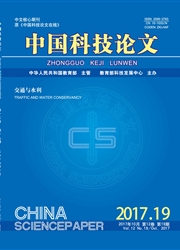

 中文摘要:
中文摘要:
采用多种电化学方法研究了一种由氢氧化镍膜电极和氧还原电极组成的电化学电池体系的氧化性能量储存行为。应用扫描电子显微镜(SEM)和X射线衍射(XRD)分析方法表征样品的结构和表面形貌。研究发现,当耦合体系中阴极电解液的氧含量较高或pH值较低时,可以明显改善氧化性能量在氢氧化镍膜电极中的储存。氧化?放电循环测试结果表明,在采用1.0mol/LNa2SO4(pH=2)作为阴极电解液的耦合体系中氧化处理600s后,氢氧化镍膜电极在第1次和第12次循环后的放电容量分别为79.0和97.9mC/cm2。这表明设计的氧化性能量储存和转换体系具有优异的电化学可逆性。
 英文摘要:
英文摘要:
The oxidative energy storage behaviors of a designed novel system comprising a nickel hydroxide film electrode and an oxygen-reducing platinum cathode were investigated by various electrochemical techniques. The structure and morphology of samples were characterized by scanning electron microscopy (SEM) and X-ray diffraction (XRD) analysis. It is found that the oxidative energy storage in the Ni(OH)2 electrodes can be obviously enhanced in the coupling system containing the cathode electrolytes with higher oxygen content or lower pH value. The results of the oxidation-discharge cycle tests show that the Ni(OH)2 film electrode oxidized in the coupling system with 1.0 mol/L Na2SO4 (pH=2) as cathode electrolyte for 600 s presents discharge capacities of 79.0 mC/cm2 at the first cycle and 97.9 mC/cm2 at the 12th cycle, suggesting the excellent reversibility of the investigated oxidative energy storage and conversion system.
 同期刊论文项目
同期刊论文项目
 同项目期刊论文
同项目期刊论文
 Surfactant-assisted photochemical deposition of three-dimensional nanoporous nickel oxyhydroxide fil
Surfactant-assisted photochemical deposition of three-dimensional nanoporous nickel oxyhydroxide fil Facile synthesis of hierarchically porous Co3O4 nanowire arrays with enhanced electrochemical cataly
Facile synthesis of hierarchically porous Co3O4 nanowire arrays with enhanced electrochemical cataly Co3O4-coated TiO2 nanotube composites synthesized through photo-deposition strategy with enhanced pe
Co3O4-coated TiO2 nanotube composites synthesized through photo-deposition strategy with enhanced pe Three-dimensional nanoporous TiO2 network films with excellent electrochemical capacitance performan
Three-dimensional nanoporous TiO2 network films with excellent electrochemical capacitance performan Co3O4-coatedTiO2 nanotube composites synthesized through photo-deposition strategy with enhanced per
Co3O4-coatedTiO2 nanotube composites synthesized through photo-deposition strategy with enhanced per 期刊信息
期刊信息
